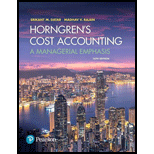
At the end of the year, the plant reported the following actual results: output of 1,500,000 using 760,000 labor-hours in total, at a cost of $2,700,000 in variable overhead and $1,850,000 in fixed overhead.
- A. Compute the budgeted fixed cost per labor-hour for the fixed overhead.
Required
- B. Compute the variable overhead spending variance and the variable overhead efficiency variance.
- C. Compute the fixed overhead spending and volume variances.
- D. Compute the budgeted fixed cost per labor-hour for the fixed overhead if Tom Saban had estimated production more realistically at the expected sales level of 1,500,000 units.
- E. Summarize the fixed overhead variance based on both the projected level of production of 1,200,000 units and 1,500,000 units.
- F. Did Tom Saban’s attempt to make his friend, the plant manager, look better work? Why or why not?
- G. What do you think of Tom Saban’s behavior overall?
Want to see the full answer?
Check out a sample textbook solution
Chapter 8 Solutions
Horngren's Cost Accounting: A Managerial Emphasis (16th Edition)
 Cornerstones of Cost Management (Cornerstones Ser...AccountingISBN:9781305970663Author:Don R. Hansen, Maryanne M. MowenPublisher:Cengage Learning
Cornerstones of Cost Management (Cornerstones Ser...AccountingISBN:9781305970663Author:Don R. Hansen, Maryanne M. MowenPublisher:Cengage Learning
